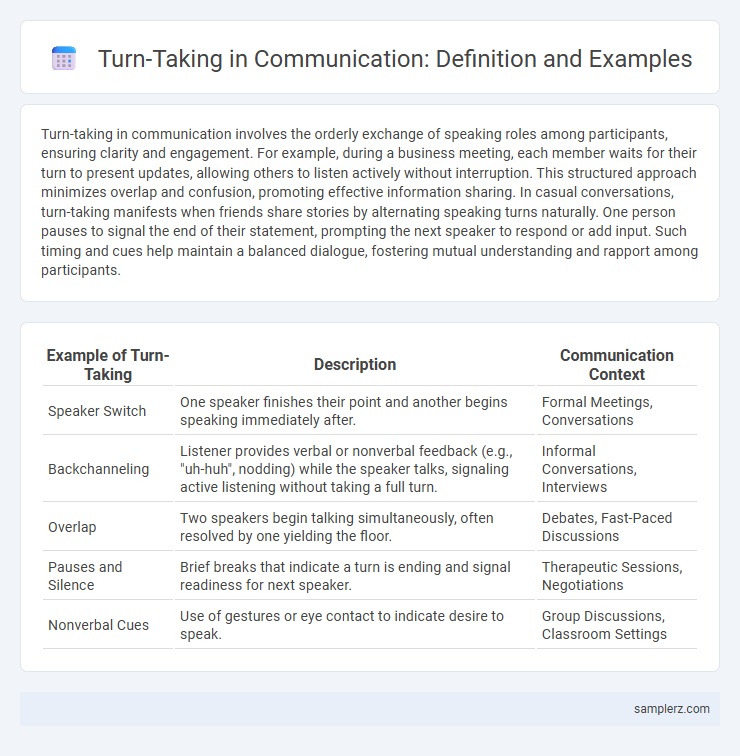Turn-taking in communication involves the orderly exchange of speaking roles among participants, ensuring clarity and engagement. For example, during a business meeting, each member waits for their turn to present updates, allowing others to listen actively without interruption. This structured approach minimizes overlap and confusion, promoting effective information sharing. In casual conversations, turn-taking manifests when friends share stories by alternating speaking turns naturally. One person pauses to signal the end of their statement, prompting the next speaker to respond or add input. Such timing and cues help maintain a balanced dialogue, fostering mutual understanding and rapport among participants.
Table of Comparison
| Example of Turn-Taking | Description | Communication Context |
|---|---|---|
| Speaker Switch | One speaker finishes their point and another begins speaking immediately after. | Formal Meetings, Conversations |
| Backchanneling | Listener provides verbal or nonverbal feedback (e.g., "uh-huh", nodding) while the speaker talks, signaling active listening without taking a full turn. | Informal Conversations, Interviews |
| Overlap | Two speakers begin talking simultaneously, often resolved by one yielding the floor. | Debates, Fast-Paced Discussions |
| Pauses and Silence | Brief breaks that indicate a turn is ending and signal readiness for next speaker. | Therapeutic Sessions, Negotiations |
| Nonverbal Cues | Use of gestures or eye contact to indicate desire to speak. | Group Discussions, Classroom Settings |
Understanding Turn-Taking in Effective Communication
Turn-taking in communication involves speakers alternating roles between speaking and listening, ensuring balanced interaction and mutual understanding. Effective turn-taking reduces interruptions, clarifies messages, and fosters engagement by allowing each participant to contribute fully. Mastering this skill enhances conversational flow and strengthens interpersonal connections.
The Role of Turn-Taking in Conversations
Turn-taking in conversations ensures equal participation and smooth information flow, preventing interruptions and overlapping speech. Effective turn-taking involves verbal cues like intonation shifts, pauses, and nonverbal signals such as eye contact or hand gestures. This structured exchange enhances mutual understanding and conversation coherence, enabling collaborative dialogue and conflict resolution.
Everyday Examples of Turn-Taking at Home
During family dinners, turn-taking allows each member to share their daily experiences without interruption, fostering clear and respectful communication. In conversations between parents and children, taking turns to speak helps maintain attention and ensures children feel heard and understood. Household decision-making discussions often rely on turn-taking to balance opinions and reach mutual agreements efficiently.
Turn-Taking in Professional Meetings
Turn-taking in professional meetings ensures each participant has a structured opportunity to contribute, enhancing clarity and efficiency in communication. Techniques such as using hand signals, nodding, or designated speaking orders facilitate smooth transitions between speakers. This structured approach reduces interruptions and promotes active listening, resulting in more productive and inclusive discussions.
Classroom Turn-Taking: Teacher and Student Interactions
Classroom turn-taking involves systematic exchanges where teachers pose questions and students respond, allowing for structured dialogue that supports learning and comprehension. Effective turn-taking techniques include wait time, signaling cues, and explicit turn allocation, which foster inclusive participation and minimize interruptions. This dynamic interaction enhances student engagement and facilitates clearer communication pathways within educational settings.
Turn-Taking in Group Discussions and Teamwork
Turn-taking in group discussions and teamwork enhances collaboration by allowing each member to contribute ideas without interruption, promoting balanced participation and clear understanding. Effective turn-taking structures in meetings help reduce misunderstandings and improve decision-making by managing speaking time and encouraging active listening. Research shows that well-regulated turn-taking correlates with higher team performance and increased satisfaction among participants.
Nonverbal Cues for Turn-Taking in Communication
Nonverbal cues such as eye contact, head nods, and hand gestures play a crucial role in signaling turn-taking during conversations. These subtle actions help regulate the flow of dialogue, allowing speakers to indicate when they are ready to speak or yield their turn without interrupting. Effective use of body language enhances mutual understanding and smooth interaction in both formal and informal communication settings.
Challenges and Barriers to Effective Turn-Taking
Turn-taking in communication faces challenges such as overlapping speech, interruptions, and cultural differences that disrupt conversational flow. These barriers hinder mutual understanding and reduce the efficiency of information exchange. Effective turn-taking requires active listening, clear cues, and respect for conversational norms to overcome these obstacles.
Cross-Cultural Differences in Turn-Taking
Cross-cultural differences in turn-taking manifest in varying pause lengths and interruptions, where some cultures value rapid responses while others prioritize longer silences for reflection. For instance, East Asian communication often exhibits extended pauses signaling respect, contrasting with Western cultures that emphasize prompt turn exchanges. Understanding these nuances prevents misunderstandings and enhances intercultural communication effectiveness.
Turn-Taking Strategies for Better Communication
Effective turn-taking strategies in communication involve clear cues such as eye contact, pauses, and intonation changes to signal when one speaker has finished and another can begin. Utilizing hand gestures and nods helps regulate conversational flow, reducing interruptions and promoting active listening. Structured turn-taking enhances clarity, ensures equal participation, and fosters a respectful exchange of ideas.

example of turn-taking in communication Infographic
 samplerz.com
samplerz.com